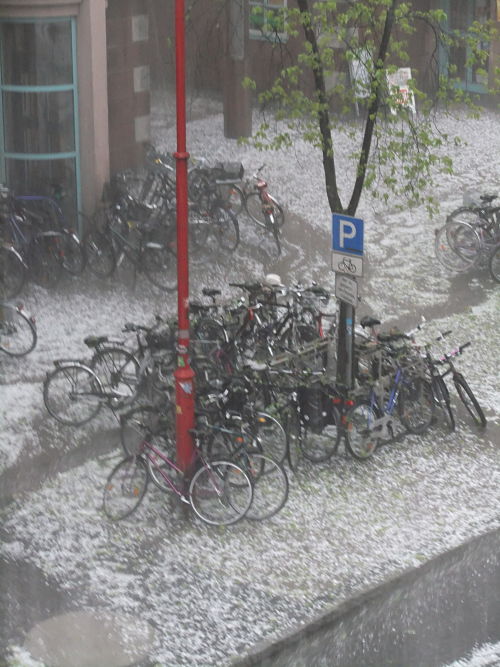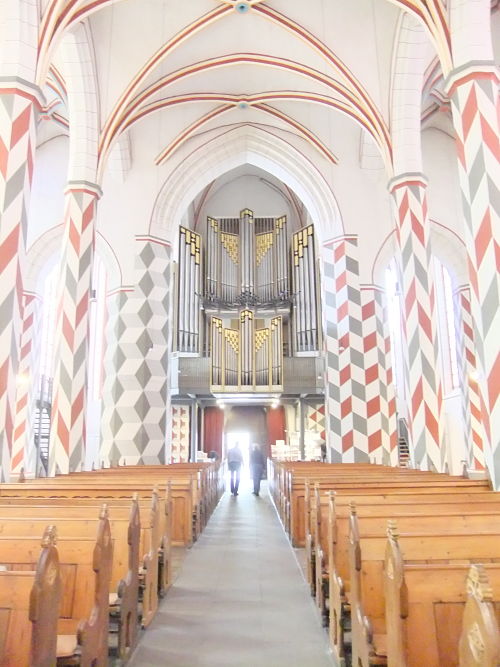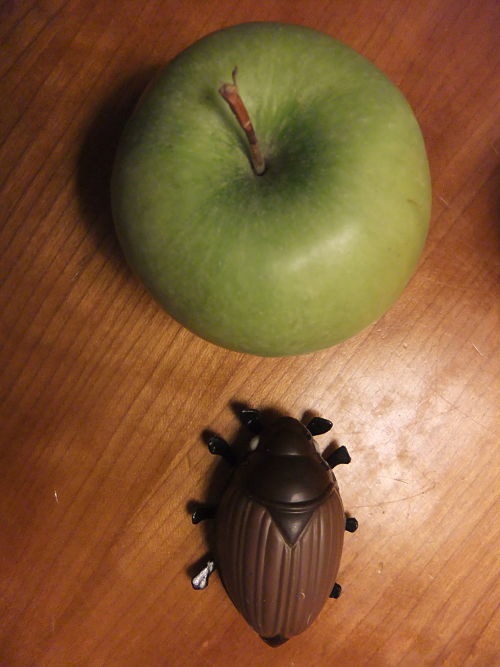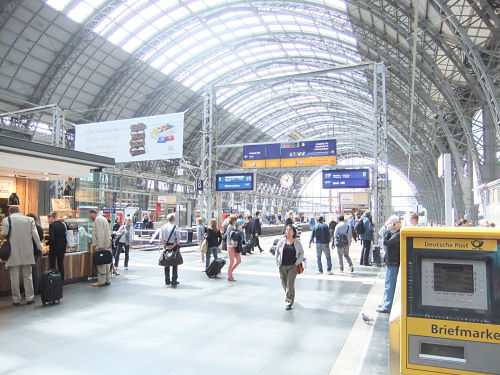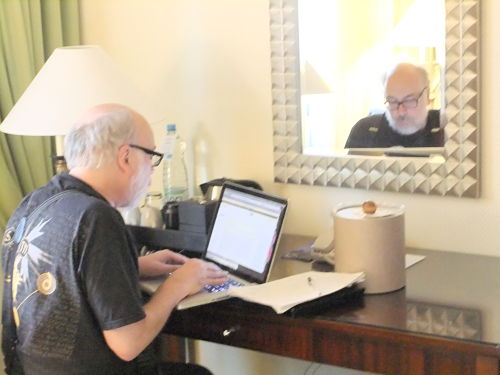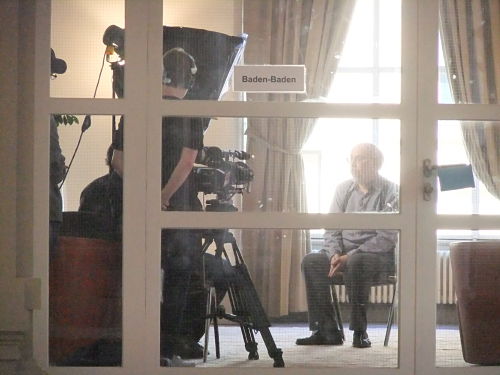How I Spent My Summer Vacation (Part One): Germany
/This is the first of a series of blog posts which will share images, videos, and impressions from my extensive lecture tour this summer across Europe. I think of these posts as the equivalent of a scrapbook. For me, they are a way of consolidating my impressions on what were truly transformative experiences and encounters. I am hoping for the reader they will function as one part travel guide and one part overview of some key figures and developments in Europe around the topics which I regularly cover here.
The Journey Begins
Over the course of ten weeks, I ended up giving more than 30 talks and visited 12 European countries at a moment of tension and transition within the European Union. As someone commented on my Facebook page near the end of the trip, "Now everyone in Europe has had the chance to hear Henry Jenkins speak at least twice."
In almost every case, it was the first time my wife and I had visited those places and so we engaged with each with curiosity and excitement. I had never really been able to spend significant amounts of time in Europe before, having not had the resources to be a foreign exchange student in high school, to do the Junior semester abroad programs as an undergraduate, or to hitchhike across Europe after graduation, all the stereotypical ways Americans get to know Europe.
As Convergence Culture began to be translated into many European languages, I felt a very strong desire to visit Europe in a more substantial and systematic way, to engage in conversation with the people who were reading the book, and to learn more about how its themes were playing out in a European context. But, the trip kept getting put off as I struggled with my decision to leave MIT and then dealt with the transition to USC, and so this summer was the first time I could make this dream into a reality.
The timing could not have been better, since I could also now use the trip to talk about a range of forthcoming projects, each of which build on the foundations of ideas introduced in Convergence Culture, including a special issue of Transformative Works and Cultures on fan activism (which I co-edited with Sangita Shreshtova and the members of my Civic Paths team), Spreadable Media: Creating Meaning and Value in a Networked Culture (Co-authored with Sam Ford and Joshua Green, and due out in January), the 20th anniversary edition of Textual Poachers: Television Fans and Participatory Culture (coming out from Routledge this fall), and Reading in a Participatory Culture (co-edited and co-written with a group of former students and researchers associated with the New Media Literacies Project, due out from Teacher's College Press by the end of 2012.) For me, these projects represent the finalization of many ideas and projects started at MIT and now reaching completion.
Finally, this summer represented a moment of transition as I start really working on book projects which represent the conceptual breakthroughs I have made since starting work at USC, and thus, the summer was a way of clearing my head, refocusing my thinking, as I prepare for some new ventures.
This trip would not have been imaginable without the hard work of Amanda Ford, my ever-resourceful assistant, who coordinated with my hosts at each of these cities to resolve the many, many details involved in pulling off a trip on this scale, certainly the most extensive, exhaustive, and exhausting trip I've ever tackled. I also could not have done it without the partnership of my wife, Cynthia, who acted as the "official photographer" on the trip (almost all of the images I will be running in this series are hers) and also helped to puncture my ego whenever needed to prevent too much swelling of the head.
Marburg
Our trip began in Germany and I recall those first few days through a deep haze -- one part end of term exhaustion, one part jet lag. But one of the more surreal aspects of our first leg was waking up from my sleep in the middle of the afternoon on the first day to the sounds of hail hitting the balcony outside my room and looking down into the streets below, more or less covered with ice. Keep in mind that this was the first week of May and that no one in Marburg could recall having seen a hail storm this late in the year before.
This is not the best of pictures, but it gives you some sense of what we saw from the hotel window. I think back on the hail storm as ironic in several senses. First, as any American will tell you, Europe suffers from a severe shortage of ice otherwise. Even when you beg waiters for ice, they return with one or two small slivers, not convinced that it is really healthy to have ice in your drinks. So, the travel gods delivered most of the ice we'd see the whole trip in one dump. And second, by the time the trip was ending, the weather in Europe was sweltering and we were on the verge of melting into the asphalt, so the move from a hail storm in Marburg to 100 degree days in Athens or Rome, says something about just how long we were on the road.
Marburg is a classic medieval German city -- narrow, winding streets, buildings with lots of "gingerbread" decorations -- and it feels as if it were a location in the fairy tales of the Brothers Grimm. This is no accident since the Brothers Grimm spent a portion of their lives here and that many of their visits into the country side to collect local folk tales which form the basis of their narratives were in the region around this town.
 As a consequence, my second really surreal encounter in Marburg was seeing this statute of our Friendly Neighborhood Spider-Man hanging outside a very old world looking comic shop.
As a consequence, my second really surreal encounter in Marburg was seeing this statute of our Friendly Neighborhood Spider-Man hanging outside a very old world looking comic shop.
 My host for this leg of the journey was Malte Hagener, who has recently published (with Thomas Elssasser) Film Theory: An Introduction Through the Senses , which offers an approach to classic problems in cinema studies through a framework that is highly appropriate to those of us working in Comparative Media Studies. I plan to use some of its chapters in my course on Medium Specificity this fall.
My host for this leg of the journey was Malte Hagener, who has recently published (with Thomas Elssasser) Film Theory: An Introduction Through the Senses , which offers an approach to classic problems in cinema studies through a framework that is highly appropriate to those of us working in Comparative Media Studies. I plan to use some of its chapters in my course on Medium Specificity this fall.
First, there was a lively informal conversation with a room full of bright undergraduates (many of whom were doing projects dealing with transmedia entertainment or fan studies or game studies). They had been asked to read my recently published essay on the Harry Potter Alliance and fan activism, which gave me a chance to talk more generally about our work on new media, youth, and political participation, and exchange perspectives on everything from the Arab Spring movement to the ways Occupy Wall Street had impacted current debates around the European economic crisis. Later that night, at the University of Marburg, I delivered the first of the trip's formal lecture dealing with the ideas from Spreadable Media.
After, Hagener and his colleagues took my wife and I on a walk through the old sector of the city and to dinner. We had arrived at the height of Germany's "cult of the white asparagus," which meant that for a few weeks each year a good chunk of the menu was dedicated to this distinctive vegetable, which was served in various soups or stews, cooked into various pastas, served as the main dish with many different kinds of sauce, or served with ham and other local meats. I had never had white asparagus before but by the time this leg was done, we would have enjoyed it for a number of meals. It is larger than the green asparagus we mostly have in the States, but it was surprisingly not at all tough or fibrous, more or less melting in your mouth, and also very sweat tasting.
Gottingen
From Marburg, we traveled by train to Gottingen, where I was greeted by Jason Mittell, who has been spending his sabbatical year in residence at Georg-August-Universität Göttingen, where he has joined a group of researchers working on contemporary and historical forms of serial entertainment. I have known Jason since he was a graduate student at the University of Wisconsin-Madison and we've worked together many times, especially through the Futures of Entertainment Consortium, and he runs one of the very best academic blogs in media studies, Just TV. Below you can see a photograph of the two of us walking through the streets of his temporary home town.
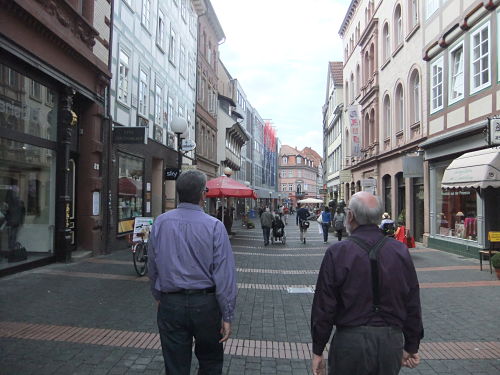 Jason, for example, took us for our first of many visits to cathedrals in Europe -- in this case, the St. Jacobikirche (St. Jacoby), which is unexpectedly decorated with candy cane red and white stripes inside. St. Jacoby is called the "dancing cathedral" because the architects used a variety of optical effects in its design which created a strange "buzz" or warping effect on the eye.
Jason, for example, took us for our first of many visits to cathedrals in Europe -- in this case, the St. Jacobikirche (St. Jacoby), which is unexpectedly decorated with candy cane red and white stripes inside. St. Jacoby is called the "dancing cathedral" because the architects used a variety of optical effects in its design which created a strange "buzz" or warping effect on the eye.
Here, you see the window of Cron und Lanz, a truly phenomenal bakery and candy shop. There had been a German Bakery in Atlanta near where I grew up, which carries enormous sentimental importance in my childhood memories. I especially associate it with these great gingerbread man cookies which we would get every year at Christmas. I still seek them out if I have reason to be in Atlanta this time of year, and my friend Laurie Baird, until recently with Turner Broadcasting, will bring me a box if we have a chance to meet. I was having fantasies of tasting authentic German gingerbread, but even though it is available year round in Atlanta, it seems to be a seasonal treat here, so no such luck.
 But, Jason introduced us to another seasonal delicacy -- chocolate Maikäfer or May Bugs, which are associated with the celebration of May Day in this part of Germany. It's hard to see them in the window of the bakery, but there was another whole window displaying various sized chocolate bugs. This is a close up of one such creature who I bought at the shop and later consumed in my hotel room (with the apples used just to give you a sense of scale).
But, Jason introduced us to another seasonal delicacy -- chocolate Maikäfer or May Bugs, which are associated with the celebration of May Day in this part of Germany. It's hard to see them in the window of the bakery, but there was another whole window displaying various sized chocolate bugs. This is a close up of one such creature who I bought at the shop and later consumed in my hotel room (with the apples used just to give you a sense of scale).
Here we see the two of us, alongside many of Jason's students and colleagues, who were all part of the the Research Unit for "Popular Seriality -- Aesthetics and Practice", shortly after an intense afternoon bull session.
 The discussion was organized around a chapter we shared from Spreadable Media , which dealt primarily with the ways the television industry understands the concept of "engagement", its struggles to adequately measure and capitalize on the value of audience participation in its franchises, and the ways these trends have shaped the push towards transmedia storytelling. But, our discussion was far reaching, covering many different points of intersection between our research projects. This was the first time I had encountered a very German academic practice. Rather than clapping after the end of a presentation, here and elsewhere in Germany, the audience rapped their knuckles on the table top.
The discussion was organized around a chapter we shared from Spreadable Media , which dealt primarily with the ways the television industry understands the concept of "engagement", its struggles to adequately measure and capitalize on the value of audience participation in its franchises, and the ways these trends have shaped the push towards transmedia storytelling. But, our discussion was far reaching, covering many different points of intersection between our research projects. This was the first time I had encountered a very German academic practice. Rather than clapping after the end of a presentation, here and elsewhere in Germany, the audience rapped their knuckles on the table top.
Below you see some members of the very engaged audience at my evening public lecture, based on my new book project, Comics...And Stuff, which deals with the ways contemporary graphic novels are helping us think about our relations to material culture and the practices of collecting in an era of eBay and other forms of networked consumption.
This project combines formal and thematic considerations of the works of nine contemporary comics artists from the Anglo-American world. This was the first time I had done a public presentation of these ideas, which are still very much taking shape in my head, so the talk had an exploratory and improvizational tone (i.e. I was partially making it up as I went along). Gottingen turned out to be the ideal audience for such an early presentation of these ideas, since there were people in the audience from my diverse fields, many of whom were doing work on popular representation, art history, popular memory, material culture, networked consumption, and above all, a surprising number doing work on comics and graphic storytelling. Among them were Daniel Stein and Alexandre Starre.) The audience was generous and generative in sharing their reactions to my ideas and helping me think out loud about this project which will dominate much of my writing time for the coming year.
Frankfurt
From there, we traveled to Frankfurt by train. Below is the Frankfurt train station, the site of an especially memorable moment of transcultural misunderstanding. As I was walking through the train station, I spotted a sign advertising Berliners. I have always been bemused by the story of John F. Kennedy's trip to Berlin where he sought to express solidarity with the German people by claiming he was also a Berliner, but ended up, via a mistranslation, announcing to the world that he was a jelly doughnut. So, I had to have a Berliner, and my wife wanted them too, so I went to the counter, only to find that the sales woman did not speak any English and I spoke no German. So, I pointed at the doughnuts and held up two fingers. She spoke very fast in German and held up three fingers. But, I only wanted two doughnuts, so insisted on two, and this went back and forth for some time, before some other customer took mercy on me, suggesting that the woman was trying to tell me that the doughnuts were three for the price of two, and so, in the end, I walked away with three.
I mean this as no insult to the people of Frankfurt, but this city was intended primarily as a bolt hole where I could lock myself away for a few days and finish off grading for my semester at USC. I had left on the last day of classes and by this point in the trip, the papers for my graduate seminar on Fandom, Participatory Culture, and Web 2.0 were coming in electronically, and I needed to take some time out to grade them in a city where I had no local contacts, no scheduled talks, and thus would not be disturbed. You can see me here grading in the hotel room.
But, ultimately, I could not visit Frankfurt without doing some exploring. Cynthia and I took a break from grading to do a walk through rain soaked city streets and to visit the Deutsche Filminstitut, which has a museum focused on the history and art of motion pictures and is highly recommended. We especially enjoyed spending time on a floor focused around 19th century forms of media. In the past, these materials would be framed as "the prehistory of cinema," but increasingly, there are the source of fascination in their own right. I am a very modest collector of such artifacts of this earlier moment of media in transition. I especially admired the juxtaposition created here between magic lantern shows (which deployed a broad array of special effects and optical manipulations) and the work of Georges Melies, which turns out to have a remarkably similar aesthetic, though these connections have rarely been explored by film scholars. The museum also has a large collection of materials associated with Charlie Chaplin, including toys, advertisements, and other collectibles, showing the transnational fan culture which grew up around his work.
Giessen
Grading completed, we then took a train to Giessen, a small, somewhat sleepy little German village, where I ran a master class for graduate students doing work on various topics in media and popular culture through International Graduate Centre for the Study of Culture (GCSC). The talk had been organized by Joern Ahrens, who I knew from his time as a visiting scholar at Comparative Media Studies, but he was unfortunately called out of town before I arrived. Nevertheless, I found my time with the students cordial and engaging, as might be suggested by these two photographs from the session.

 While I was interacting with the students, Cynthia got to explore a quaint old country cemetery which was just on the edge of the campus. This is one of the many beautiful images she captured there.
While I was interacting with the students, Cynthia got to explore a quaint old country cemetery which was just on the edge of the campus. This is one of the many beautiful images she captured there.
Stuttgart
From there, we traveled to Stuttgart, where I participated in FMX, a trade-show/festival focused around animation, games, special effects, and other forms of digital entertainment. I was featured on a special track of programming focused on transmedia which was co-hosted by the fine folks at 5-D, which runs transmedia and world building themed events here in Los Angeles.
Today's program included Scott Walker, one of the key organizers of the Los Angeles area Transmedia Meetup, who has done some innovative thinking about audience engagement strategies through his company, Brain Candy; Femke Wolting, who is part of the acclaimed team at Submarine Channel, which has done many transmedia projects in both fictional and documentary storytelling; and Nuno Bernardo from beActive, a transmedia from Portugal producer who recently published The Producer's Guide to Transmedia .
I delivered a talk on the Future of the Content Industries, which would be a core talk I delivered multiple times across Europe. But, for me, the high point was getting to participate in an open-ended conversation about world building and story telling with Alex McDowell, the noted British-born production designer who most recently has been shaping the look and feel of the upcoming Superman movie, and Shekhar Kapur, the Indian born producer associated with The Bandit Queen and the Elizabeth movies, among other projects. We brought very different perspectives to the topic in terms of our professional stakes and our cultural backgrounds. This conversation, and subsequent talks with Kapur at the conference dinner, ranked as one of the intellectual high points of my time in Europe. The exchange was marked by constant shifts in tone from the philosophical or even "spiritual" to the intellectual to the personal to the professional, each of us circling around some of the most challenging issues surrounding the nature of entertainment in a transmedia and transnational era. I am sharing the video with you here thanks to special efforts by the 5D and FMX staffs, so thanks guys.
5D: The future of Storytelling in Transmedia at FMX 2012 from Dave Blass on Vimeo.
For more about transmedia at FMX, check out Scott Walker's very perceptive blog post, which shares his impressions not only of the day of programming I participated in but also other highlights from the week long festival. See also here an interview I did about transmedia for a German blog as part of the publicity build up for my appearances in his country.
While I was at the convention, I also shot an interview with Klaus Uhrig, a producer for Bayerischer Rundfunk. Uhrig is preparing a documentary for national television dealing with issues of collecting, ownership, and publishing, as phenomenon undergoing profound transition as we move into the era of cloud computing. More and more, we are not going to own the media we consume -- whether television programs, movies, or books -- but rather we will access them (in effect, rent them) from their publishers. As someone deeply invested in collector culture and very excited to own so many of my favorite media texts in DVD, I am a bit concerned about the uncertainities of access such an era is apt to produce. After all, Borders has never gone into my home and removed books I've bought from my bookshelf, but Amazon has been called out several times now for removing or disabling digital books from people's iPads and Kindles. And, where media availability is concerned, what iTunes and Hulu giveth, they can also withdrawal on their whim, something which is going to have serious consequences for media educators who want to predictably show certain core works semester after semester to their students. So, I am not normally cranky about the future, as anyone reading this blog knows, but to me, there are disturbing implications for our current moment of corporate "curation" and cloud based publishing, which we urgently need to be discussing. You see here a photograph of the producers interviewing me for the program.
Next Time: Portugal


